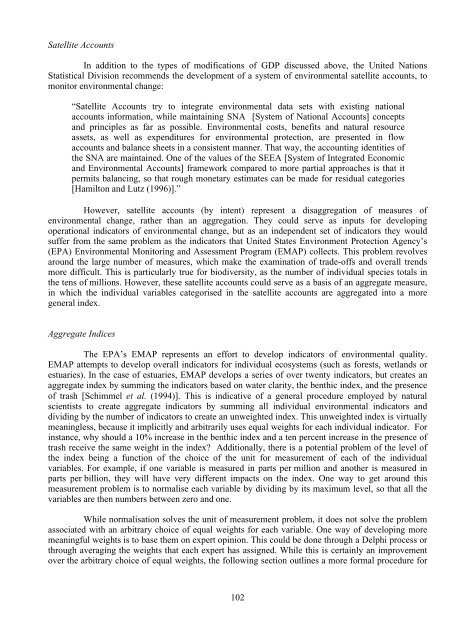Valuation of Biodiversity Benefits (OECD)
Valuation of Biodiversity Benefits (OECD)
Valuation of Biodiversity Benefits (OECD)
- No tags were found...
Create successful ePaper yourself
Turn your PDF publications into a flip-book with our unique Google optimized e-Paper software.
Satellite AccountsIn addition to the types <strong>of</strong> modifications <strong>of</strong> GDP discussed above, the United NationsStatistical Division recommends the development <strong>of</strong> a system <strong>of</strong> environmental satellite accounts, tomonitor environmental change:“Satellite Accounts try to integrate environmental data sets with existing nationalaccounts information, while maintaining SNA [System <strong>of</strong> National Accounts] conceptsand principles as far as possible. Environmental costs, benefits and natural resourceassets, as well as expenditures for environmental protection, are presented in flowaccounts and balance sheets in a consistent manner. That way, the accounting identities <strong>of</strong>the SNA are maintained. One <strong>of</strong> the values <strong>of</strong> the SEEA [System <strong>of</strong> Integrated Economicand Environmental Accounts] framework compared to more partial approaches is that itpermits balancing, so that rough monetary estimates can be made for residual categories[Hamilton and Lutz (1996)].”However, satellite accounts (by intent) represent a disaggregation <strong>of</strong> measures <strong>of</strong>environmental change, rather than an aggregation. They could serve as inputs for developingoperational indicators <strong>of</strong> environmental change, but as an independent set <strong>of</strong> indicators they wouldsuffer from the same problem as the indicators that United States Environment Protection Agency’s(EPA) Environmental Monitoring and Assessment Program (EMAP) collects. This problem revolvesaround the large number <strong>of</strong> measures, which make the examination <strong>of</strong> trade-<strong>of</strong>fs and overall trendsmore difficult. This is particularly true for biodiversity, as the number <strong>of</strong> individual species totals inthe tens <strong>of</strong> millions. However, these satellite accounts could serve as a basis <strong>of</strong> an aggregate measure,in which the individual variables categorised in the satellite accounts are aggregated into a moregeneral index.Aggregate IndicesThe EPA’s EMAP represents an effort to develop indicators <strong>of</strong> environmental quality.EMAP attempts to develop overall indicators for individual ecosystems (such as forests, wetlands orestuaries). In the case <strong>of</strong> estuaries, EMAP develops a series <strong>of</strong> over twenty indicators, but creates anaggregate index by summing the indicators based on water clarity, the benthic index, and the presence<strong>of</strong> trash [Schimmel et al. (1994)]. This is indicative <strong>of</strong> a general procedure employed by naturalscientists to create aggregate indicators by summing all individual environmental indicators anddividing by the number <strong>of</strong> indicators to create an unweighted index. This unweighted index is virtuallymeaningless, because it implicitly and arbitrarily uses equal weights for each individual indicator. Forinstance, why should a 10% increase in the benthic index and a ten percent increase in the presence <strong>of</strong>trash receive the same weight in the index? Additionally, there is a potential problem <strong>of</strong> the level <strong>of</strong>the index being a function <strong>of</strong> the choice <strong>of</strong> the unit for measurement <strong>of</strong> each <strong>of</strong> the individualvariables. For example, if one variable is measured in parts per million and another is measured inparts per billion, they will have very different impacts on the index. One way to get around thismeasurement problem is to normalise each variable by dividing by its maximum level, so that all thevariables are then numbers between zero and one.While normalisation solves the unit <strong>of</strong> measurement problem, it does not solve the problemassociated with an arbitrary choice <strong>of</strong> equal weights for each variable. One way <strong>of</strong> developing moremeaningful weights is to base them on expert opinion. This could be done through a Delphi process orthrough averaging the weights that each expert has assigned. While this is certainly an improvementover the arbitrary choice <strong>of</strong> equal weights, the following section outlines a more formal procedure for102












